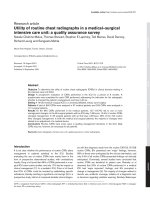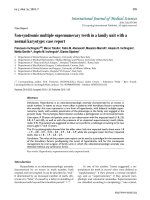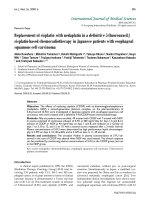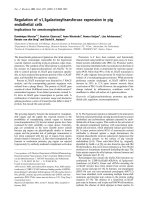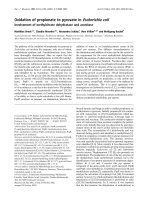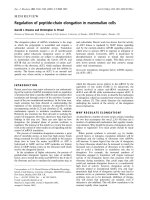Báo cáo y học: "Utility of routine chest radiographs in a medical–surgical intensive care unit: a quality assurance survey"
Bạn đang xem bản rút gọn của tài liệu. Xem và tải ngay bản đầy đủ của tài liệu tại đây (43.36 KB, 5 trang )
commentary
review
reports
research
Available online />Research article
Utility of routine chest radiographs in a medical–surgical
intensive care unit: a quality assurance survey
Natalie Chahine-Malus, Thomas Stewart, Stephen E Lapinsky, Ted Marras, David Dancey,
Richard Leung and Sangeeta Mehta
Mount Sinai Hospital, Toronto, Ontario, Canada
Correspondence: S Mehta,
Introduction
It is not clear whether the performance of routine CXRs alters
management in patients admitted to the ICU. Studies
evaluating the use of routine CXRs have mainly been in the
form of prospective observational studies, with contradictory
results. Fong et al found that 48% of CXRs performed in a sur-
gical ICU were routine studies, and only 17% had an impact on
clinical management [1]. In a pediatric ICU, Price et al found
that 37% of CXRs could be avoided by establishing specific
indications, thereby resulting in significant cost savings [2]. In a
prospective study, Hall et al compared bedside clinical diagno-
sis with the diagnosis made from the routine CXR [3]. Of 538
routine CXRs, 8% presented new ‘major’ findings; however,
58% of these were anticipated by the clinical examination, and
only 3.4% of all routine CXRs presented findings not clinically
anticipated. Conversely, several studies have concluded that
routine CXRs are beneficial to patient care. Brainsky et al
observed that 20% of routine CXRs performed in a medical
ICU had ‘major important’ findings, and 8% prompted a
change in management [4]. The majority of changes related to
diuretic use, antibiotic coverage, initiation of a diagnostic test,
or decisions regarding ventilator weaning. Similarly, Bekemeyer
CHF = congestive heart failure; CXR = chest radiograph; ETT = endotracheal tube; ICU = intensive care unit; IJ = internal jugular; NGT = nasogas-
tric tube; PA = pulmonary artery.
Abstract
Objective To determine the utility of routine chest radiographs (CXRs) in clinical decision-making in
the intensive care unit (ICU).
Design A prospective evaluation of CXRs performed in the ICU for a period of 6 months. A
questionnaire was completed for each CXR performed, addressing the indication for the radiograph,
whether it changed the patient’s management, and how it did so.
Setting A 14-bed medical–surgical ICU in a university-affiliated, tertiary care hospital.
Patients A total of 645 CXRs were analyzed in 97 medical patients and 205 CXRs were analyzed in
101 surgical patients.
Results Of the 645 CXRs performed in the medical patients, 127 (19.7%) led to one or more
management changes. In the 66 surgical patients with an ICU stay < 48 hours, 15.4% of routine CXRs
changed management. In 35 surgical patients with an ICU stay ≥ 48 hours, 26% of the 100 routine
films changed management. In both the medical and surgical patients, the majority of changes were
related to an adjustment of a medical device.
Conclusions Routine CXRs have some value in guiding management decisions in the ICU. Daily
CXRs may not, however, be necessary for all patients.
Keywords chest radiograph, intensive care unit, quality assurance, routine radiography
Received: 13 August 2001
Accepted: 16 August 2001
Published: 6 September 2001
Critical Care 2001, 5:271-275
© 2001 Chahine-Malus et al, licensee BioMed Central Ltd
(Print ISSN 1364-8535; Online ISSN 1466-609X)
Critical Care October 2001 Vol 5 No 5 Chahine-Malus et al
et al found that 27% of both routine and non-routine CXRs
revealed clinically unsuspected abnormalities, but that non-
routine films were more likely to change investigative or thera-
peutic management [5].
Although there may be benefits related to the performance of
routine CXRs, there are also significant associated economic
and clinical costs. Adverse consequences associated with
patient repositioning for the performance of CXRs can
include patient discomfort, hypotension, oxyhemoglobin
desaturation, and displaced endotracheal tubes (ETTs), naso-
gastric tubes (NGTs), or vascular catheters.
The financial costs, potential adverse clinical consequences,
and the uncertainty surrounding the value of routine CXRs in
previously published studies prompted us to prospectively
evaluate their utility in our medical–surgical ICU as part of a
quality assurance survey. The goals of this study were to
determine the percentage of routine and non-routine radio-
graphs that change management in our medical–surgical ICU,
and to determine the specific resultant management changes.
Materials and methods
All medical and surgical patients admitted to the ICU at
Mount Sinai Hospital, a university-affiliated hospital, over a 6-
month period were enrolled and prospectively evaluated.
Because this was an observational study, no attempt was
made to alter the performance of routine CXRs. Informed
consent was not obtained from patients because this study
was part of an ICU quality assurance program.
For each CXR performed (routine and non-routine), the clini-
cal fellow completed a data sheet documenting the patient’s
ICU admission diagnosis, the indication for the CXR, and any
resulting changes in management.
The ICU team, consisting of the attending physician, a clinical
fellow, and a group of housestaff, interpreted the daily CXRs.
CXRs were defined as routine if they were performed first
thing in the morning or at ICU admission. In our ICU, the on-
call resident decides which patients should have routine
CXRs. CXRs performed for a specific indication (e.g. desatu-
ration, fever) were defined as non-routine.
Changes in patient management were categorized as ETT
placement or change in position, central line placement or
change in position, thoracostomy tube placement or change
in position, ventilator setting change, antibiotics started, con-
gestive heart failure (CHF) treated, lung or pleural biopsy,
thoracentesis, or other.
Analysis
Given that medical and surgical patients often have different
complications and varying lengths of stay, the data for each
were analyzed separately. Surgical patients were divided into
two groups retrospectively by ICU length of stay ≥ 48 hours
or < 48 hours. Medical patients were defined as non-surgical
patients admitted from a medical ward, the emergency
department, or another hospital.
The hospital’s computerized radiographic database (eFilm
workstation 1.5.2, © 2000; eFilm Medical Inc. Toronto,
Ont., Canada) was reviewed to determine whether there
were additional radiographs not documented on a daily
datasheet. Indications for these non-routine CXRs were not
determined retrospectively. All data were entered into a
computerized database (Excel 97; Microsoft Corp.,
Redmond, Washington, USA).
Results
Over a 6-month period, 850 CXRs were performed in 198
patients: 645 CXRs in 97 medical patients and 205 CXRs in
101 surgical patients. Major admitting diagnoses for the
medical and surgical patients are presented in Tables 1 and
2, respectively.
Table 3 presents the various indications for the CXRs in the
medical and surgical patients. The two most common indica-
tions for non-routine CXRs were following a procedure to
verify the position of a medical device and exclude complica-
tions, and for evaluation of a suspected new medical condi-
tion. Table 4 presents the management changes resulting
from the CXRs in each of the patient groups.
Medical patients
Of 645 CXRs performed in medical patients, 463 (71.8%)
were routine radiographs. Of 182 non-routine CXRs, 60 data
sheets were completed (37 following a procedure, 21 for a
suspected change in condition, and two for other reasons). In
addition, almost one-half of the patients (45/97) had at least
one CXR performed per day in addition to the morning CXR.
Of the 645 CXRs, 127 (19.7%) led to a change in manage-
ment, with some CXRs prompting more than one change. Of
463 routine films, 103 (22.2%) resulted in 107 changes in
management. The majority of these changes (58.0%) related
to the adjustment of a medical device, most commonly the
ETT, the central line, the chest tube, or the NGT. The balance
of these changes (42.0%) led to a change in clinical manage-
ment, specifically the treatment of CHF, the addition of anti-
biotics, the performance of bronchoscopy, or a change in
ventilator settings.
Of the 60 non-routine films with completed data sheets, 24
(40%) resulted in 27 changes in management (15
adjustments of a medical device, and 12 changes in clinical
management).
Surgical patients with an ICU stay < 48 hours
There were 66 patients in this group, with a total of 78 CXRs
recorded. Seventy-one (91.0%) of these CXRs were routine.
commentary
review
reports
research
Of the 78 CXRs, 12 (15.4%) changed management, all of
which were routine; one CXR prompted two changes.
Surgical patients with an ICU stay
≥≥
48 hours
There were 127 CXRs recorded in 35 patients in this group,
and 100 (78.7%) were routine films. Nine of 35 (25.7%)
patients had an average of 1.6 additional films over a period
of 16 days. Thirty (23.6%) of the 127 CXRs changed man-
agement. There were 29 management changes in 26 routine
CXRs (12 changes in position of a medical device, and 17
changes in clinical management). There were also four non-
routine CXRs, which resulted in five changes in clinical man-
agement and one change in position of a medical device.
Discussion
In this quality assurance survey, we observed in our medical
patients that 22% of all routine CXRs, and 40% of non-
routine CXRs, led to a change in management. Similarly, in
Available online />Table 1
Major admitting diagnoses in medical patients (
n
= 97)
Diagnosis n
Respiratory 45
Pneumonia 13
Acute respiratory distress syndrome 9
Acute COPD exacerbation 8
Alveolar hemorrhage 7
Other* 8
Sepsis 12
Cardiovascular 15
Congestive heart failure 6
Myocardial infarction 5
Cardiac arrest 2
Other 2
Gastrointestinal 10
Gastrointestinal bleeding 6
Liver failure/cirrhosis 3
Other 1
Drug overdose 7
Other
†
8
COPD, chronic obstructive pulmonary disease. * Pneumonitis, central
alveolar hypoventilation, pulmonary embolus.
†
Febrile neutropenia,
myasthenic crisis, idiopathic thrombocytopenic purpura.
Table 2
Major admitting diagnoses in surgical patients (
n
= 101)
Intensive care unit stay
< 48 hours ≥ 48 hours
Diagnosis (n = 66) (n = 35)
Post-operative monitoring 56 19
Gastrointestinal 36 13
Ear, nose and throat 9 1
Orthopedic 3 1
Thoracic 1 1
Vascular 1 1
Other 6 2
Respiratory failure 2 3
Sepsis 2 3
Post-partum complications 2 0
Cardiovascular 1 2
(congestive heart failure, cardiac arrest)
Gastrointestinal complications* 1 5
Other 2 3
* Gastrointestinal complications include common bile duct repair, small
bowel obstruction, perforated viscus and peritonitis.
Table 3
Indication for chest radiograph (CXR)
Medical patients (n = 97) Surgical patients
< 48 hours (n = 66) ≥ 48 hours (n = 35)
Total number of CXRs performed 645 78 127
Routine CXRs (n) (% total) 463 (72%) 71 (91%) 100 (79%)
Non-routine CXRs (n) (% total) 182 (28%) 7 (9%) 27 (21%)
Data sheet completed (n)60110
Post-procedure 37 (62%) 0 4 (40%)
Clinical change 21 (35%) 1 (100%) 6 (60%)
Other 2 (3%) 0 0
surgical patients with ICU stays longer than 48 hours, 26% of
routine and 40% of non-routine films changed management.
In surgical patients with ICU stays shorter than 48 hours, a
smaller percentage of routine CXRs (17%) resulted in a
change in management. In both the medical and surgical
patients, the two most common changes resulting from the
CXR were adjustment of a medical device, and the diagnosis
and treatment of CHF. Furthermore, 46% of the medical
patients and 26% of the surgical patients with an ICU stay
≥ 48 hours had one or more CXRs performed, in addition to
the routine CXR, on a given day.
Our study probably overestimates the utility of routine CXRs
owing to the introduction of selection bias, since the houses-
taff decide which patients have morning CXRs. In contrast,
the percentage of non-routine CXRs that alter therapy may
have been underestimated, as 63–68% of these radiographs
had no data sheets completed.
Our results are very similar to those of Fong et al, who
observed that only 17% of routine CXRs prompted a change
in clinical management in a surgical ICU [1]. Other studies
have yielded varied results, most probably due to the hetero-
geneous patient population in the ICU setting, as well as
large differences in study design and terminology [3,4,6,7].
For instance, Silverstein et al found that 27% of routine CXRs
performed in a surgical ICU presented worse or new findings;
however, only 1.4% of these required immediate action [6].
Our study evaluated the impact of routine CXRs without
having recorded the information yielded by the bedside physi-
cal examination. Thus, given that no clinical correlation was
made, the impact of CXRs on clinical management was most
likely overestimated. This is supported by Hall et al, who
reported that the incorporation of information from the clinical
examination reduces the utility of routine CXRs, with only
3.4% leading to a change in management. The majority of the
changes (78%) were related to repositioning of an ETT or a
NGT [3]. Similarly, another prospective study reported that
general physical examination had a sensitivity greater than
90% in predicting clinical change, which led to a 52% reduc-
tion in the number of CXRs performed [7].
Numerous studies have concluded that only selected patients
should have routine CXRs performed [1,2,6–10]. Several
investigators have evaluated the need for CXRs to check
placement of a medical device. Palesty et al concluded that
CXRs are not necessary following the placement of a central
line over a guide wire, as they observed no complications in
380 such changes [10]. Gray et al found that clinicians were
fairly accurate in determining the placement of subclavian or
internal jugular (IJ) vein pulmonary artery (PA) catheter intro-
ducer sheaths, but the clinicians were not accurate for clinical
determination of ETT or PA catheter position [9]. In contrast,
Gladwin et al found that the sensitivity of a clinical decision
protocol for detecting complications and malpositions of IJ
catheter insertion was only 44%. They concluded that routine
CXRs are necessary following IJ catheter insertion [11]. The
major difference in these opposing studies is that Gray et al
evaluated mostly IJ canulations with a PA catheter introducer
sheath, whereas Gladwin et al inserted longer central venous
catheters, which have a higher likelihood of being placed in
the right atrium.
Daily CXRs are often performed in ICUs to assess the place-
ment of medical devices. However, there are currently several
Critical Care October 2001 Vol 5 No 5 Chahine-Malus et al
Table 4
Management changes resulting from chest radiographs (CXRs)
Medical patients Surgical patients
< 48 hours ≥ 48 hours
Routine Non-routine Routine Non-routine
(n = 103) (n = 24) (n = 26) (n = 4)
CXR that changed management (n) (% total) 127 (20%) 12 (15%)
†
30 (24%)
Total number of management changes* 107 27 13 29 6
Adjustment/insertion of medical device 62 (58%) 15 (56%) 5 (38%) 12 (41%) 1 (17%)
Ventilator setting changes 1 (1%) 0 0 0 0
Antibiotic treatment 3 (3%) 4 (15%) 0 0 0
Treatment of congestive heart failure 8 (8%) 1 (4%) 4 (31%) 8 (28%) 1 (17%)
Thoracentesis 7 (6%) 1 (4%) 0 3 (10%) 1 (17%)
Bronchoscopy 11 (10%) 3 (11%) 0 0 1 (17%)
Other 15 (14%) 3 (11%) 4 (31%) 6 (21%) 2 (33%)
Percentages may not add up to 100% because of rounding. * Some CXRs resulted in more than one management change.
†
Only routine CXRs
changed management.
ways to clinically judge the position of these devices. Once it
has been established that the devices are in the correct posi-
tion, clinical evaluation including ETT position at the lips
could potentially eliminate a large number of CXRs, resulting
in significant cost savings.
Conclusion
The authors conclude that although routine CXRs prove to
have some value in the management of critically ill patients,
they may not be warranted for all patients, specifically surgi-
cal patients admitted for post-operative monitoring. Moreover,
the use of clinical decision protocols may reduce the number
of CXRs performed following placement of a medical device.
Competing interests
None declared.
Acknowledgements
The authors would like to thank the ICU housestaff and fellows for their
invaluable assistance with data acquisition.
References
1. Fong Y, Whalen GF, Hariri RJ, Barie PS: Utility of routine chest
radiographs in the surgical intensive care unit. Arch Surg
1995, 130:764-768.
2. Price MB, Chellis Grant MJ, Welkie K: Financial impact of elimi-
nation of routine chest radiographs in a pediatric intensive
care unit. Crit Care Med 1999, 27:1588-1593.
3. Hall JB, White SR, Karrison T: Efficacy of daily routine chest
radiographs in intubated, mechanically ventilated patients.
Crit Care Med 1991, 19:689-693.
4. Brainsky A, Fletcher RH, Glick HA, Lanken PN, Williams SV,
Kundel HL: Routine portable chest radiographs in the medical
intensive care unit: Effects and costs. Crit Care Med 1997, 25:
801-805.
5. Bekemeyer WB, Crapo RO, Calhoon S, Cannon CY, Clayton PD:
Efficacy of chest radiography in a respiratory intensive care
unit. Chest 1985, 88:691-696.
6. Silverstein DS, Livingston DH, Elcavage J, Kovar L, Kelly KM: The
utility of routine daily chest radiography in the surgical inten-
sive care unit. J Trauma 1993, 35:643-646.
7. Bhagwanjee S, Muckart DJJ: Routine daily chest radiography is
not indicated for ventilated patients in a surgical ICU. Intensive
Care Med 1996, 22:1335-1338.
8. Strain DS, Kinasewitz GT, Vereen LE, George RB: Value of
routine daily chest x-rays in the medical intensive care unit.
Crit Care Med 1985, 13:534-536.
9. Gray P, Sullivan G, Ostryzniuk P, McEwen TAJ, Rigby M, Roberts
DE: Value of postprocedural chest radiographs in the adult
intensive care unit. Crit Care Med 1992, 20:1513-1518.
10. Palesty JA, Amshel CE, Dudrick SJ: Routine chest radiographs
following central venous recatheterization over a wire are not
justified. Am J Surg 1998, 176:618-621.
11. Gladwin MT, Slonim A, Landucci D, Gutierrez DC, Cunnion RE:
Canulation of the internal jugular vein: Is postprocedural
chest radiography always necessary? Crit Care Med 1999, 27:
1819-1823.
Available online />commentary
review
reports
research
